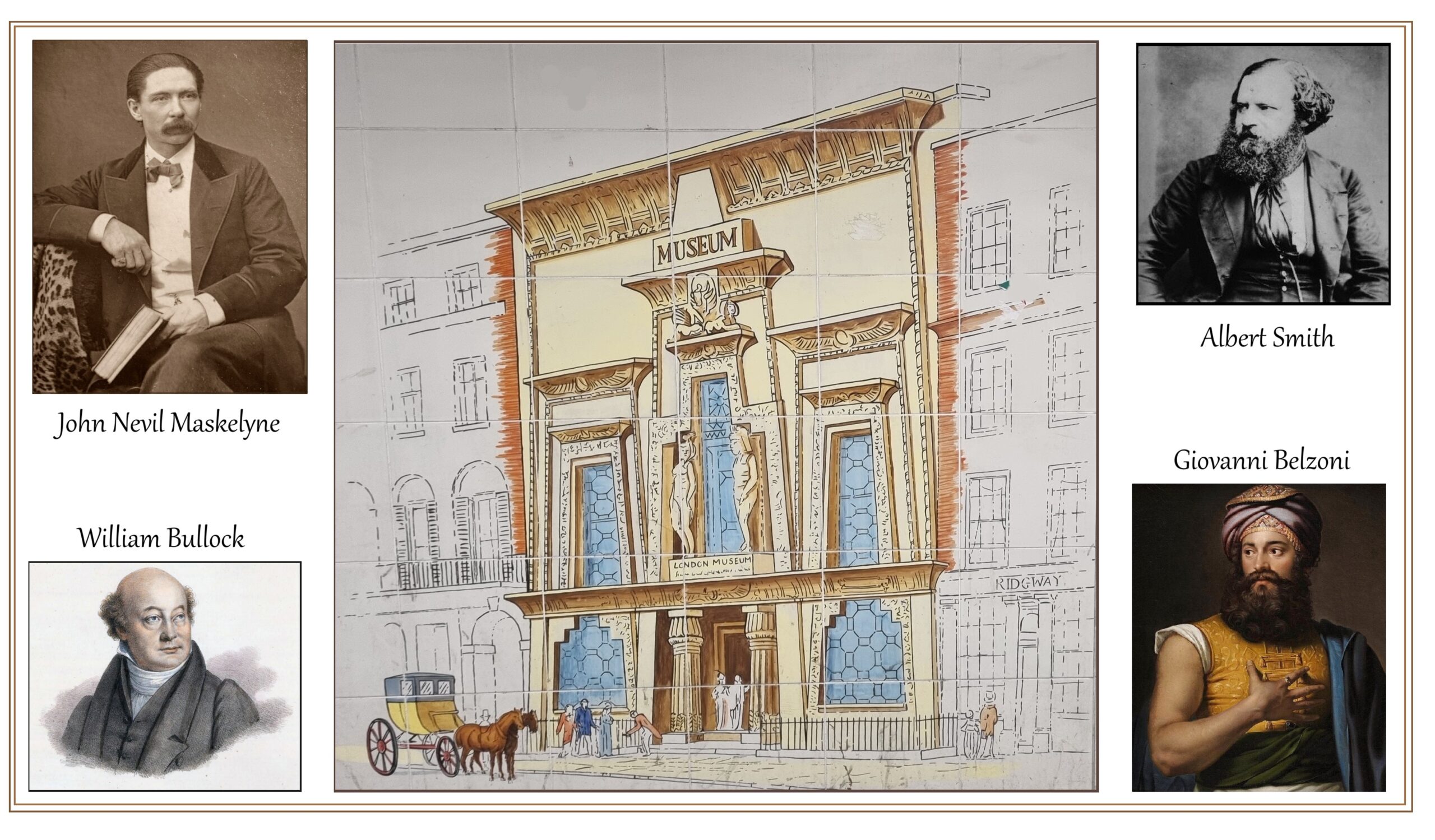
The Egyptian Hall stood on Piccadilly from 1812 to 1905, an extraordinary piece of architecture of the ‘sticks-out-like-a-sore-thumb’ type. However, that was nothing compared to those involved in the displays and shows presented there. The breadth of their interests was extraordinary. Those ninety-three years were filled with eccentric acts, revolutionary exhibitions, some very large egos, and – for the most part – supreme business acumen. In this post, I look at some of these people, using the evolution of the hall over the years as a backdrop.

William Bullock: Traveler, collector, showman, naturalist, silversmith, mine owner, author, utopian and ‘Pickwickian entrepreneur’
Around 1800, William Bullock (c.1773-1849) had opened in Liverpool a museum displaying his collection of ‘natural and foreign curiosities, antiquities, and productions of the fine arts’. Nine years later he brought the collection to London, finding a temporary home at 22 Piccadilly. It was a spectacular success, and in 1812 he opened a new, permanent home for his collection: The Egyptian Hall, 170-172 Piccadilly. The building, consisting of several display rooms, was built on an L-shaped site, with part of it behind the neighbouring 166-169. Bullock had chosen his site well; its busy but wealthy location meant “it could appeal to the best circles but also employ the techniques of show business to bring people in” (McWilliam). Those techniques were employed with ruthless efficiency by Bullock and his successors.
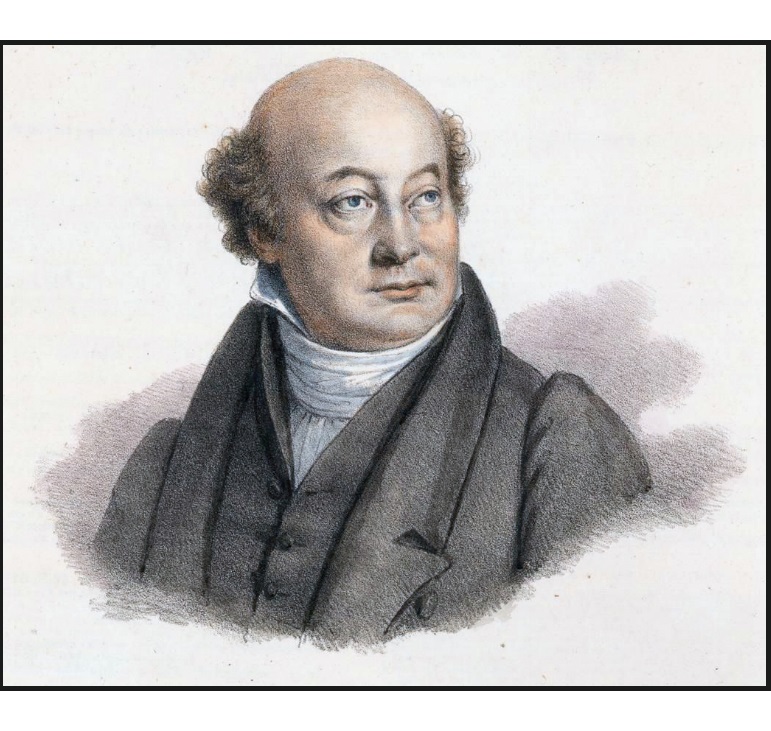
With ancient Egypt en vogue following Napoleon’s invasion and the Battle of the Nile, Bullock had employed architect Peter Robinson, a specialist in historical pastiche, to create as a façade an approximate copy of the temple of Tentyra. The resemblance was loose indeed: According to Pevsner, Robinson’s efforts were “muddled”, while essayist Leigh Hunt described the frontage as “a blow to the mind like a heavy practical joke”. Sphinxes, hieroglyphs, scarabs, and statues of Isis and Osiris by Sebastian Gahagan featured on the external decoration. It opened as the London Museum, housing Bullock’s collection spread across a ‘Great Room’ directly behind the vestibule, with arms and armour in a ‘medieval’ room on the first floor, and a diorama of stuffed mammals in an approximation of their habitat in a larger room, the ‘Pantherion’, which for some reason was approached via an artificial basaltic cave.
← William Bullock, looking reasonably Pickwickian
Admission was a shilling, which wasn’t cheap, but passers-by could hardly miss it and the new attraction drew in sufficient crowds to make Bullock a profit. He had his finger on the pulse of popular expectation, and constantly adapted his offering to suit changing tastes. This began in 1815, when he fitted out the Pantherian as a gallery for art exhibitions, and started adding temporary attractions.
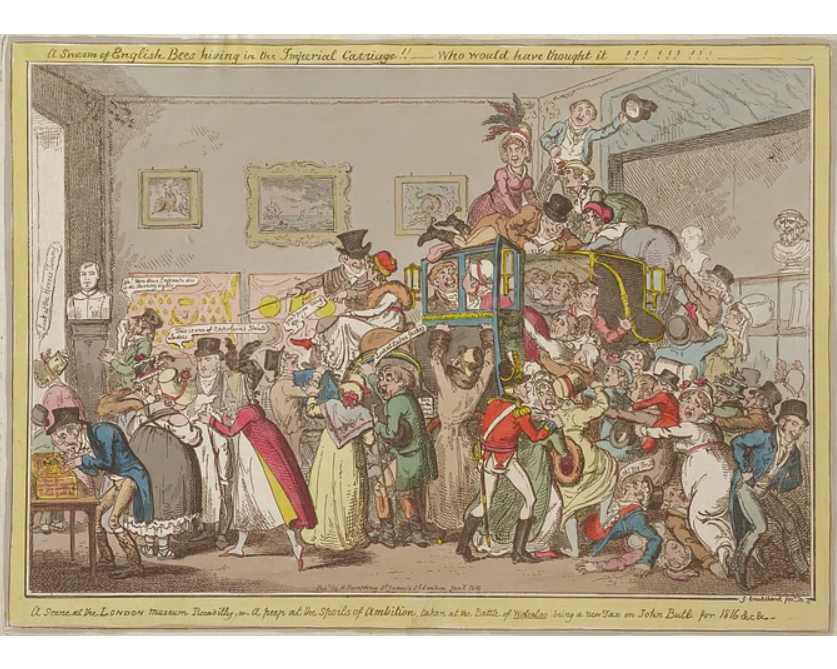
The first of these, in 1816, was Napoleon’s carriage: Captured at Waterloo and designed as kitchen, office, bedroom and dressing room as well as transport, this extraordinary object attracted 200,000 visitors and made Bullock a profit of £1 million in today’s terms. Then in 1819, with the permanent collection losing its appeal, he unsentimentally sold it off, allowing more temporary exhibitions which included something repulsive to modern sensibilities: The ‘freak show’. Also, vast French paintings, too big for the Royal Academy close by, briefly became a speciality; then single-artist exhibitions took off. The hall became the most fashionable exhibition space available for hire in London, with “the façade of a pharaonic temple and the internal volume of a Nile hippopotamus” (Hamilton).
← Cruikshank’s ‘Peep at the Spoils of Ambition’, satirising popular enthusiasm for Napoleon’s carriage.
Giovanni Belzoni: Barber, hydraulics expert, circus strongman, fugitive, inventor, explorer, Egyptologist
In 1821, Bullock gave the Great Room a gaudy Egyptian-themed makeover which made even less historical sense than the façade, and found the perfect collection to display there: That of another extraordinary man, the six feet seven inch tall Italian Giovanni Belzoni (1778-1823). This sometime barber, student of hydraulics and circus strongman had fled Rome in the face of Napoleon’s advance, and fled the Netherlands to avoid certain arrest. Having failed to sell a hydraulic pump of his own devising to the ruler of Egypt, he changed tack and became an explorer and Egyptologist. He collected artifacts from the tomb of Seti I, which he had discovered, and other sites close by. Belzoni’s remarkable collection included Seti’s extraordinary sarcophagus now residing in the Soane Museum, and a huge bust of Ramesses II in the British Museum.
→ Giovanni Belzoni, in a posthumous portrait by Jan Kruseman (1824). He died of dysentery in the Kingdom of Benin, Africa. Ironically, Benin was not his intended destination. That was Timbuktu, but as he was about to set off, diplomatic permission for his journey was withdrawn.
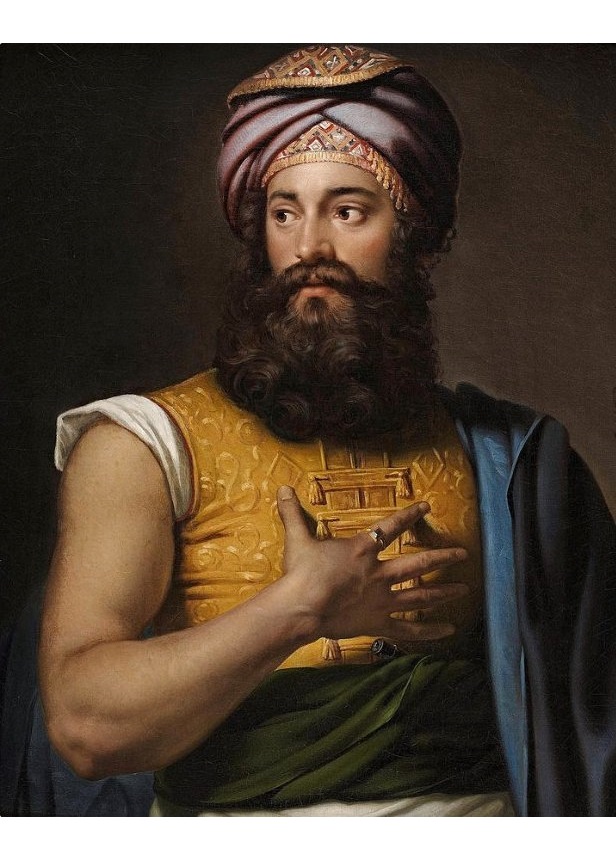
The next exhibition starred a Sami (Lapp) family and included short sleigh rides for visitors. The exhibition arose from a failed attempt by Bullock to introduce reindeer to Britain as livestock; the Sami family were brought over with the reindeer initially to care for them, but became part of the display when Bullock’s plans changed and were widely praised for their intelligence and gentleness. Then Mexico took centre stage, after Bullock had made a tour of the newly independent country with his son, buying up thousands of souvenirs. The exhibition and related book brought him international renown, opening the eyes of the British public to the financial possibilities of the country. Once again, a native was part of the display, this time an Indian from Texcoco, José Cayetano Ponce de Leon, described in the exhibition catalogue as “docile and extremely intelligent” and who spoke a little English. Bullock’s ground-breaking displays, and his inclusion of natives who could converse with visitors about the contents of the exhibition, suggests that he used these “innovative ideas to transform material culture from the outlandish to a field for sympathetic understanding” (Pearce). However, the more widespread modern view remains that the displays were simply racist, and were little better than the freak shows in the same building.
By this time, Bullock was ready to leave. In March 1825 he sold his lease to his nephew by marriage, George Lackington. The Mexican exhibition remained open until September, when it was auctioned in one lot for 275 guineas. Bullock returned to Mexico, where he hoped to prosper in silver mining. He travelled with his family, miners, and Ponce de Leon as his servant, but the scheme was a disaster and he gave up on the idea. Next stop was the US, where he attempted to set up a utopian society on the banks of the Ohio river. This – it will not surprise you – also failed, and he returned to London to live out his remaining years in obscurity.
George Lackington: Publisher, bookseller; miserly on the provision of artificial white elephants
Anyone would seem dull in comparison to Bullock, but George Lackington (1777-1844), a bookseller and publisher who had adopted the business model of ‘pile ’em high, sell ’em cheap’, at least proved himself to be just as masterly at managing the Egyptian Hall. He first displayed the Burmese imperial state coach, and there was some lively debate as to how many elephants would have been used to pull it. Suggestions varied between two and thirty; Lackington opted for two artificial white pachyderms, probably to keep costs down, but maybe because he couldn’t fit any more in the exhibition space. In 1831, he reconstructed the building to include two shops and a bazaar – thereby bringing in guaranteed rental income – along with two venues above, suitable for exhibitions and concerts. One shop was taken by a medicinal chemist, the other initially by a bookseller, later by Robert Jackson, the tea merchant better known these days as Jackson’s of Piccadilly. There followed an increasing number of freak shows, including the original Siamese twins and a ‘living skeleton’, Claude Seurat, who turned out to have an exceptionally voracious tapeworm in his gut. These were interspersed with higher artistic endeavour, mainly paintings, but a speaking automaton, exhibition billiards matches and educational lectures were among Lackington’s many offerings. He died a rich man in 1844; his remaining 28 years’ lease was sold at auction at Garroway’s coffee house in the City, for the sum of £6,250 (£650,000 today).
Tom Thumb & Benjamin Haydon: Talented entertainer versus bankrupt painter
Two very different personalities rented space in the Egyptian Hall, to catastrophic effect, soon after Lackington’s death. In 1846, artist and lecturer Benjamin Haydon (1786-1846), held in high regard by some but a man who found it too easy to make enemies and too difficult to make artistic compromises, was plagued by debt. Having been in debtors’ prison three times already, he was rapidly running out of options. As a last throw of the dice, he put on an Easter exhibition of his work at the Hall, a place where he had experienced some popularity in earlier years. The Banishment of Aristides was the centrepiece, but Haydon showed the worst possible timing, at least for his ego. Appearing in the concert room was General Tom Thumb, real name Charles Stratton (1838-83), around three feet tall and managed by his distant cousin P.T. Barnum. During Easter week 12,000 paid to see Stratton’s performances, raising around £125 a day (£12,000 today). This was no surprise as he was genuinely talented, combining singing, dancing, and story-telling, and had appeared before an amused Queen Victoria twice. Haydon suffered the indignity of friends, colleagues, former clients, and royalty come to the Egyptian Hall, only to pass by his exhibition on their way to see Stratton. He was devastated, lamenting that just 133½ people – the half was a child – visited him in his deserted gallery, despite 400 invitations being sent out. On 18th June, just two months after this debacle, he deposited journals and paintings for safekeeping with a friend, poet Elizabeth Barret, and four days later shot himself. There was sympathy and some appreciation of his work, but Charles Dickens, one of the 133½, considered Haydon untalented and didn’t bother hiding his views following the painter’s death.
Albert Smith: Author, lecturer, mountaineer, raconteur
In 1848 the hall hosted Banvard’s Mississippi, the latest in a line of moving panoramas, this one 12 feet high and half-a-mile long. In 1849, it was the site of a public meeting at which the Great Exhibition was announced by civil servant Henry Cole, who also created the first commercial Christmas card. Charles Stratton appeared for a final time in 1852, the same year that Albert Smith (1816-1860), author, mountaineer, and friend of the omnipresent Dickens, bought the lease. In his show, he recounted his 1851 ascent of Mont Blanc. As with Stratton, a royal command performance for the Queen aided his popularity. The show ran for 2,000 performances over six years, helping to popularise mountaineering in the UK. Smith was a great raconteur; the first half of the show had him recount to great hilarity his journey from London to the base of the mountain, imitating the eccentrics – mostly British – he met on the way. The second half had a painted diorama move behind him as he recounted his climb in prose, song, and verse. Smith altered the show each season to keep it fresh; at one point he had St. Bernard dogs walking along the aisles for children to pet. After the show closed, he travelled to China and returned with another entertainment themed around his latest adventures. This kept him busy until just four days before his death, at the young age of 44.
→ Albert Smith: Author, playwright, mountaineer, and – not that you’d guess from the picture – phenomenally successful entertainer known as the ‘Baron of Piccadilly’
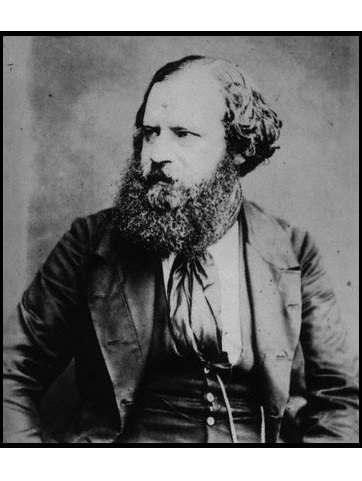
Meanwhile, the room housing art exhibitions had been named the Dudley Gallery in 1851 when it provided a temporary home for the valuable collection of old masters owned by Lord Ward, later the 1st Earl Dudley, while a private gallery was built within his Park Lane home. The Dudley Gallery Art Society was named after the space and, following the departure of Ward’s collection, regularly organised exhibitions there. This description from 1882 gives an idea of the space: It was “one long room, scarcely larger than a handsome drawing-room. The floor is carpeted and a bright fire burns in an open stove. Sofas and stuffed chairs make the business of picture viewing easy, no picture hanging so far away from some comfortable seat that the visitor need stand to see it.” The New English Art Club, founded in 1885 as a progressive alternative to the Royal Academy, was famous for its internal feuds (“talent is abundant among the members … but sincerity is lacking”) yet found the time between arguments to hold many of its biannual exhibitions at the Dudley Gallery.
By 1854, the chemist had been taken over by James Epps & Co., “the oldest purely homeopathic chemists in the kingdom” according to the Morning Leader. Thus, a bust of Samuel Hahnemann, the German physician and father of homeopathic medicine, sat in its window staring out at Piccadilly passers-by for decades. The company also leased the considerable basement beneath the building, probably to store its most famous product, drinking chocolate. What with Jackson’s teas in the other shop, the hall must have smelt constantly of refreshing beverages.
John Maskelyne: Illusionist, inventor, enemy of spiritualists
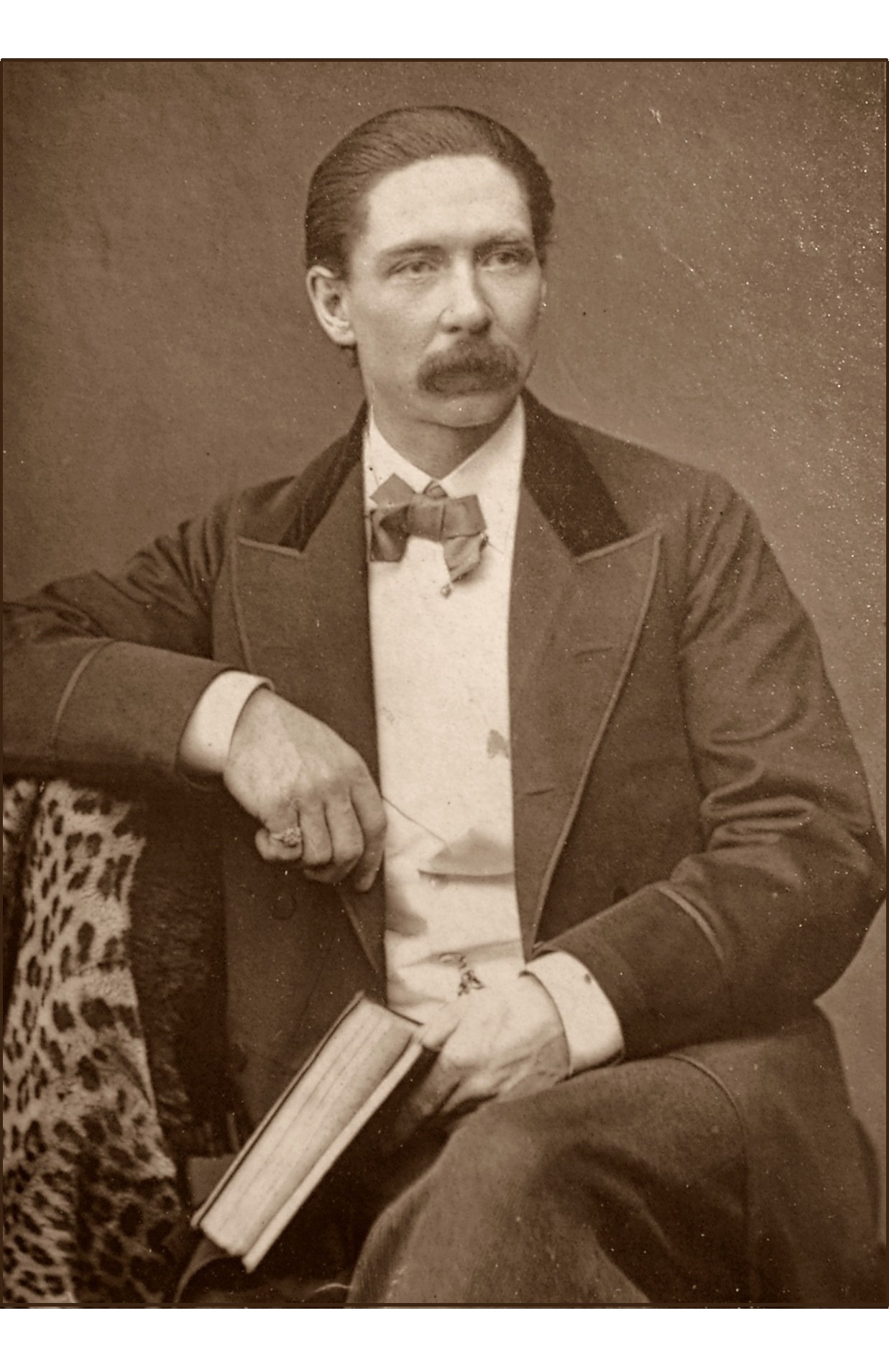
Illusionist John Nevil Maskelyne (1829-1917) took over the venue in 1873 for three months and stayed more than thirty years. He turned it into ‘England’s home of mystery’ using the 300-capacity room that had previously hosted Charles Stratton and Albert Smith, while continuing the art exhibitions and other entertainments elsewhere in the building. He and a colleague, cabinet maker George Cooke, sought to debunk so-called spiritualists and other ‘supernatural’ charlatans by reproducing their acts using, Maskelyne emphasised, simple trickery. They also made illusion a dramatic performance rather than a music hall turn; a show would typically involve several tricks, followed by a short play starring the man himself centring on illusions. This was all eminently respectable, and as a result matinées drew in families with young children. Indeed, Maskelyne claimed to have invented the matinée, with actors like Henry Irving joining in when they saw how popular daytime performances were. He also first performed the ‘vanishing lady’ trick at the Egyptian Hall, in 1886, and was at one time president of the Magic Circle.
More bizarrely, Maskelyne has a footnote in history as the man who invented the cubicle door lock for London toilets that required the insertion of a penny to operate, thereby indirectly being responsible for the phrase ‘to spend a penny’.
← John Nevil Maskelyne: Magician, debunker of hokum, President of the Magic Circle. Inventor of the pay-toilet lock mechanism, matinée performances and an early type of film projector.
In 1896, decades after Banvard’s moving half-mile of Mississippi, an invention producing moving pictures had been astonishing learned societies. A stampede of promoters raced to show different versions of the invention to a fee-paying public. The Lumière brothers at the Regent Street Polytechnic were the first, but on 19th March one of Maskelyne’s illusionists, David Devant, having obtained a ‘theatrograph’ machine invented by Robert Paul, followed suit – beating Paul himself by two days. Maskelyne saw the possibilities of the new medium, and even starred in one of Paul’s earliest films, Maskelyne: Spinning Plates (1896). Films became a central part of the show. Maskelyne and his son Nevil, as inventers themselves, even created their own projector that attempted to do away with the irritating flicker of other machines. Nevil patented it as the Mutagraph but it was never produced commercially.
→ Advertisement for the ‘animated photographs’ projected using the Mutagraph, c.1900.
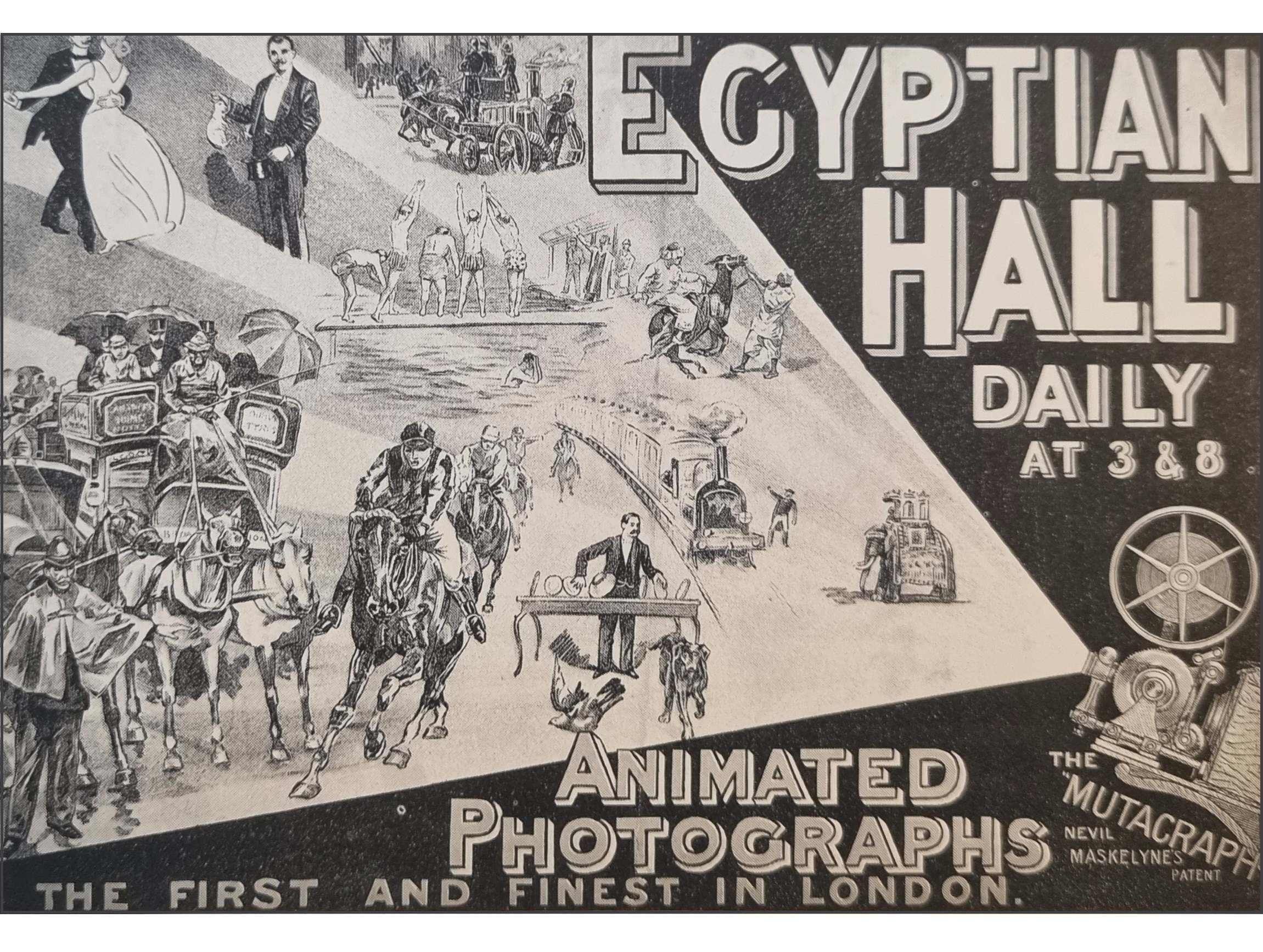
Goodbye Piccadilly …
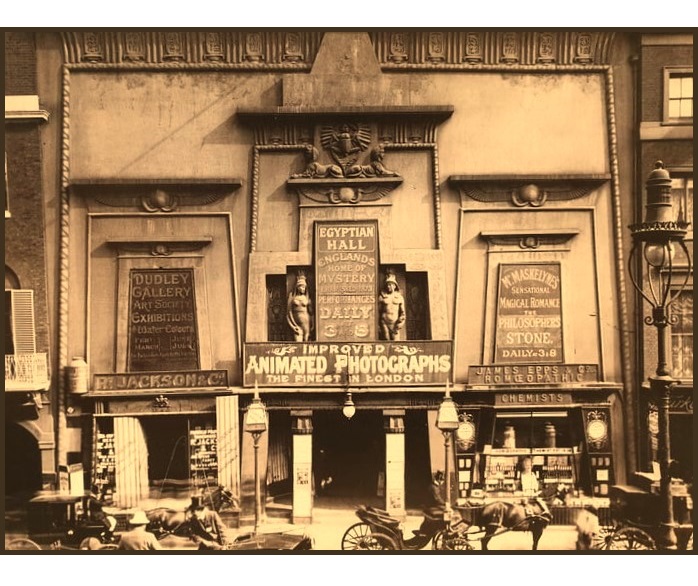
The Mutagraph was the last innovation at the Egyptian Hall. In 1903 its demise was announced; only the remaining lease prevented immediate demolition. Maskelyne stated that a larger hall could be built on the site, but later conceded he couldn’t secure the extra land needed. Regret was expressed in newspapers, but Piccadilly was changing. Historic town houses, mansions and concert venues were all giving way to offices and shops, particularly at the Circus end.
← The Egyptian Hall c.1900, with the entrance to Epps chemist on the right, Jackson’s on the left and the various delights within the hall itself advertised above including ‘improved animated photographs’. Ironically, the Maskelyne stage production is the ‘The Philosopher’s Stone’, referring to the mythical substance that could guarantee immortality. When this image was taken, the hall had just five years left.
The Egyptian Hall finally met its end in April 1905, along with the adjacent 166-169. In truth, the site was too valuable, the architecture too crude, the interior too small, lacking in merit and in need of extensive restoration. Reminiscences from later years referred to it as “squalid” and “dingy”. Furthermore, arguments over the need for a fire curtain in the room used by Maskelyne suggest the licencing authority was only too happy to see it go.
James Epps & Co. relocated to 60 Jermyn Street, to the south of Piccadilly. The bust of Samuel Hahnemann went with it. Jackson’s was intent on occupying new premises on the site of its old shop, and after rebuilding, it remained at 172 Piccadilly until 1979.
As for the main attraction, George Cooke died in February 1905, and David Devant replaced Cooke as business partner. Maskelyne and Devant moved the show to St George’s Hall, Langham Place, officially opening in April the same year. This remained the home of the Maskelyne shows, in due course taken over by his son Nevil, until 1933. It was damaged by bombs during the war and demolished soon after.
The New English Art Club continued exhibiting at the Dudley Gallery until 1904; it had to take its next exhibition on tour before finding new premises at the Alpine Club on Savile Row. It still exists, offering workshops and classes, and puts on an annual show at the Mall Galleries. The 41st and final exhibition by the Dudley Gallery Art Club at the Hall opened in March 1905 for just a few weeks. Then they too began using the Alpine Club.
→ The Egyptian Hall, early 1905. The Epps store has gone. Jackson’s is still trading. The sign in the centre is advertising Maskelyne’s relocation to St. George’s Hall.
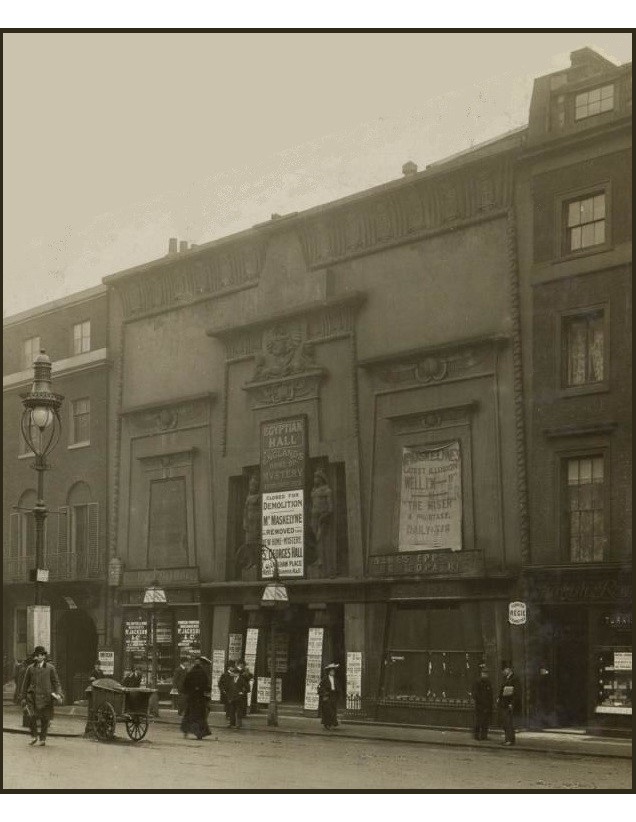
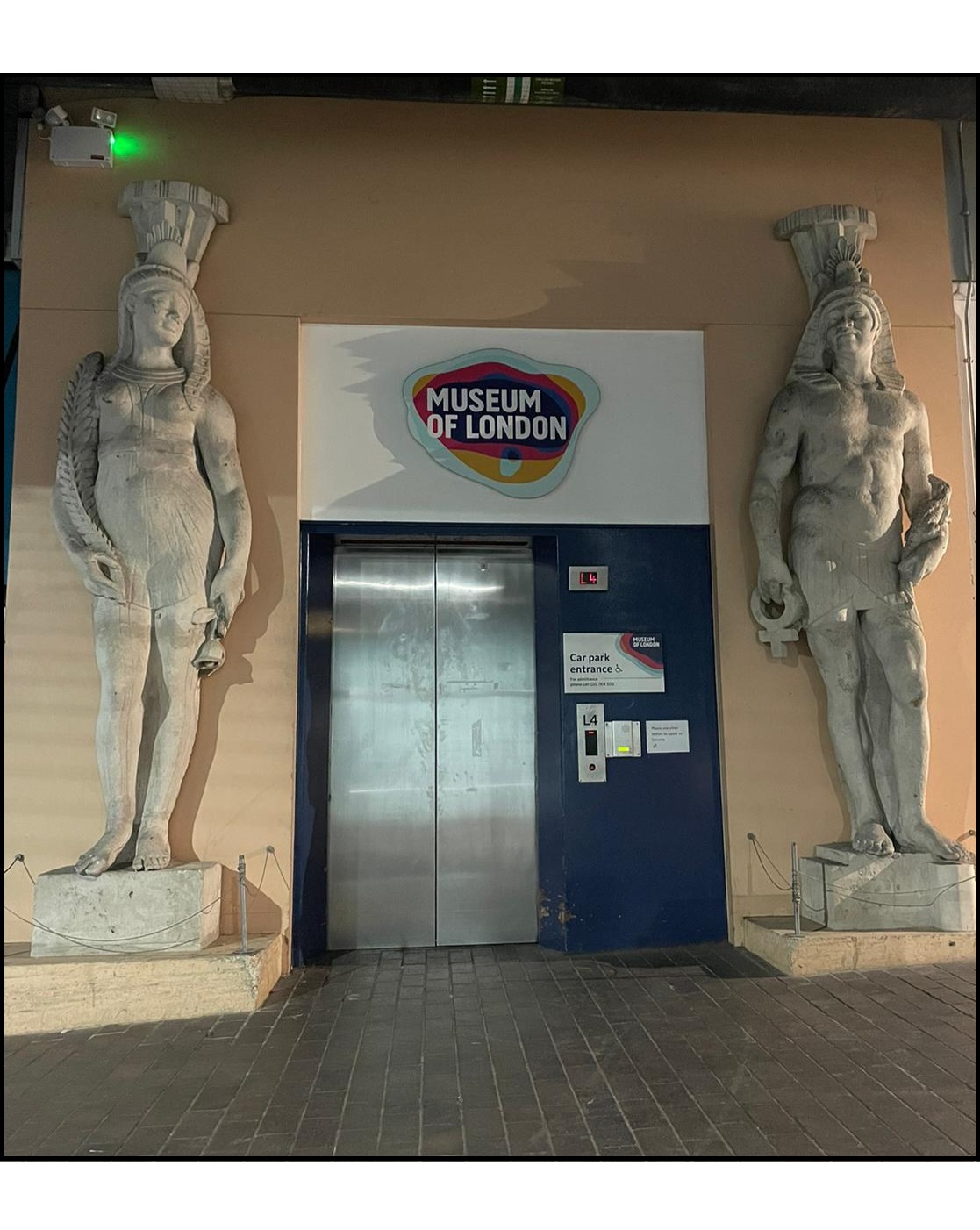
The statues of Isis and Osiris, made of Coade stone, were saved. After a time in “a grimy front garden on the Euston Road” (claimed the Illustrated London News), they found a home at the Museum of London – now renamed the London Museum, the very name that originally adorned the Egyptian Hall. Admittedly, the home provided wasn’t very good: Despite the museum’s 2023 closure prior to relocation to Smithfield, the statues have been left behind – for the time being – standing either side of an old car park lift entrance, out of sight of most of the public. Osiris still clasps a young crocodile, as he has for 212 years.
← Isis (left) and Osiris, diligently guarding a car park lift.
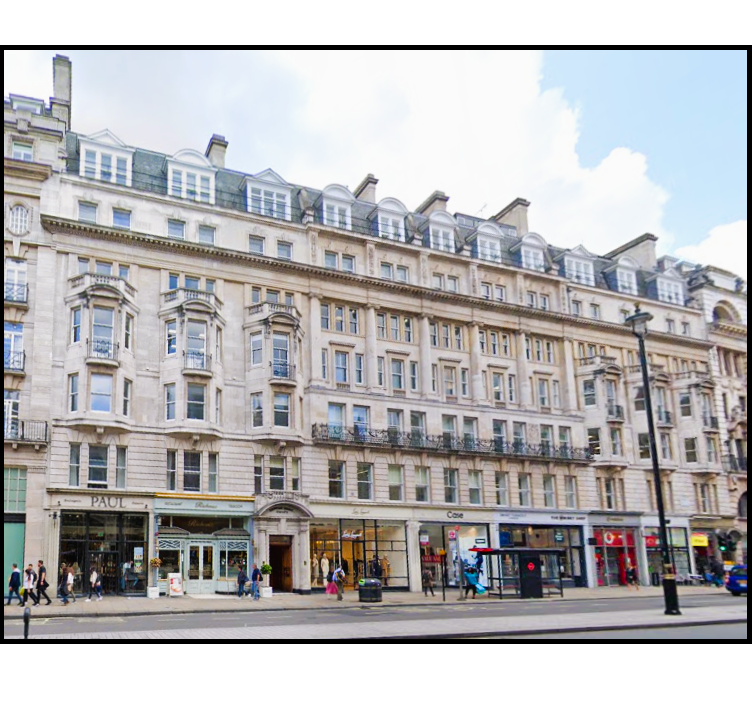
On the vacant site rose a long office block with retail units on the ground floor. The half of the replacement block covering the site of the Egyptian Hall was named Egyptian House; the half covering 166-169 Dudley House. The new building was described as “a row of unnecessarily tall houses of rather commonplace character” in a contemporary Globe report, while the Evening Standard described the block as a “lofty skyscraper”; bizarre as it has all of seven storeys. More recently Niklaus Pevsner laid into it, describing it as a “composition so tepid that its symmetry barely registers”. He’s right, although it isn’t helped by its neighbours being the same height and bulk. ‘From the ridiculous to the sub-prime’, you might say.
← The façade of Egyptian House (the half on the left) and Dudley House in 2019. Passers-by may be puzzled by the names, as there is nothing Egyptian or indeed Dudley-ish about the building.
The New Egyptian Hall: Three liquidations in 30 months
No. 170 Piccadilly, part of Egyptian House, opened as the New Egyptian Hall Cinematograph in 1907, with a capacity of 123. Films were initially supplied by Pathé Frères, and there were continuous performances with accompaniment on a Bechstein grand piano. In the basement was a Japanese tea room, roughly where James Epps once stored his cocoa powder, with waitresses dressed as geishas. The cinema’s policy was to present wholesome entertainment, clearly aimed at the same middle classes who had visited its predecessor. However, a dangerous exit passing “beneath the kinematograph chamber” i.e. under the projection room, and a small fire soon after opening led to problems. In 1909, the London County Council used the only weapon at its disposal: Withdrawal of the venue’s music licence. The cinema soldiered on briefly without anyone touching the ivories, but by late 1909 the managing company – showing none of the flair of its 19th century predecessors – went into liquidation. The cinema remained closed for most of 1910 while structural alterations created a larger, safer auditorium on two levels, with the tea room retained. The increased capacity of 180 wasn’t enough to prevent it failing again in 1911, reopening in October that year under yet another new owner, before failing again in May 1912. All this despite, according to the Kinematograph Weekly, no nearby competition and “one of the best sites in London”. Some blamed the last two failures on those very alterations that improved its safety, as the screen was left ten feet above the stalls level to be visible from the balcony. The space was a ladies’ outfitters by March 1913, but in 1923 became a luggage store, which it has remained for a hundred years.
The New Dudley Gallery opened next door to the New Egyptian Hall, at 169 Piccadilly, in early 1906. This put it just in front of the original gallery location. Meanwhile, the Dudley Gallery Art Society, which didn’t use the new gallery, renamed itself the Old Dudley Gallery Art Society to differentiate itself. It seems to have faded away shortly after. The New Dudley Gallery was almost as big a failure as the New Egyptian Hall, closing c.1915. It was in retail use by 1918.
In May 1938 Jasper Maskelyne, grandson of John, announced plans to build a new Egyptian Hall of Mystery close to Piccadilly Circus, although the exact site was not disclosed. Nothing more was heard. And that, finally, was the end of the Egyptian Hall.
It wasn’t the end of Jasper. As a Major within the Army’s Camouflage Experimental Section, he went on to confuse German forces with dummy tanks and trucks prior to the battle of El Alamein, and repeated the trick in the South East of England prior to D-Day. Benedict Cumberbatch is slated to play him in a forthcoming film.
Postscript
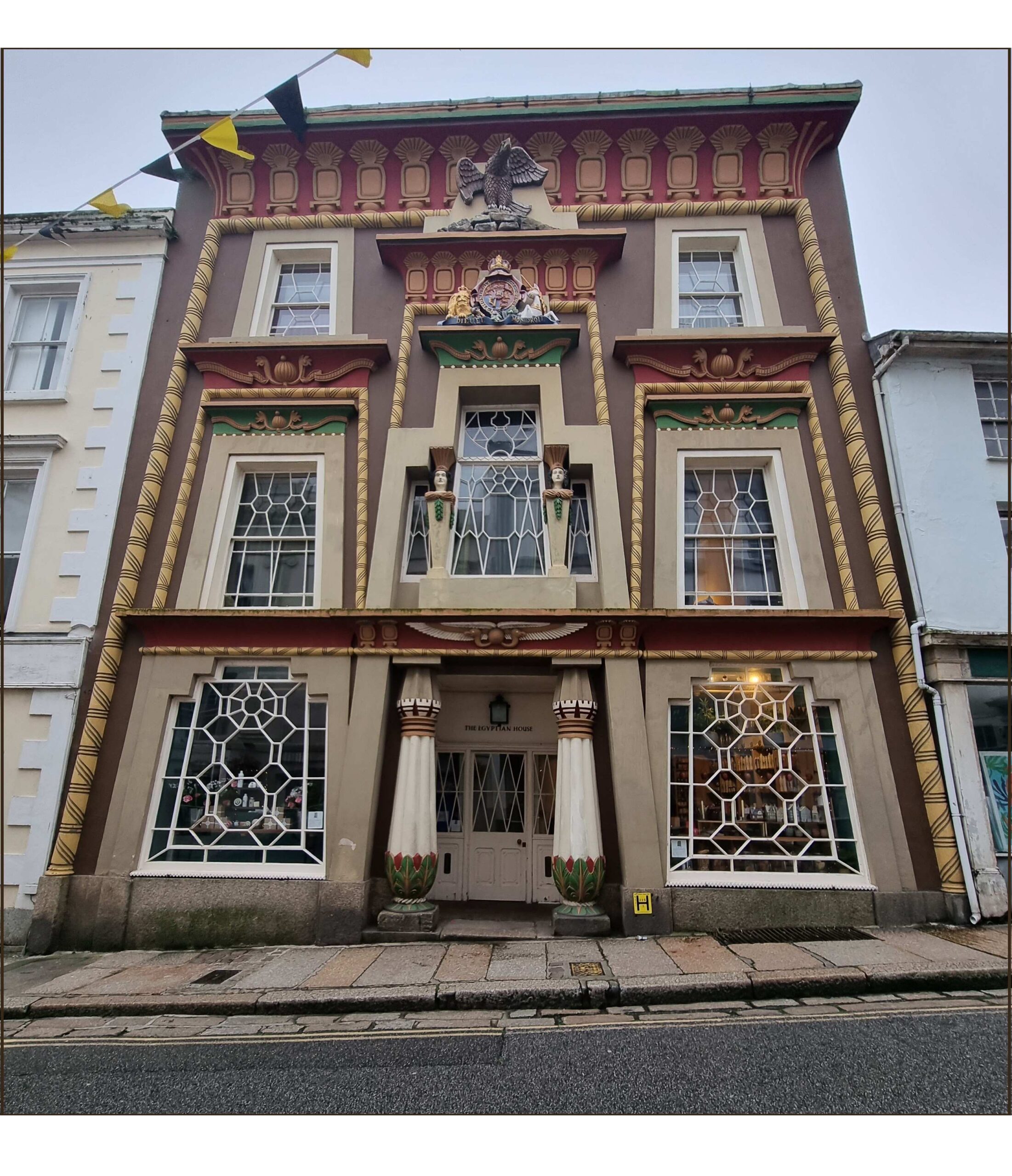
A similar façade to that of the Egyptian Hall still exists in Penzance, Cornwall. The Egyptian House in Chapel Street, completed in 1836, is a startling building. On a smaller scale than its inspiration, and with additional second floor windows that reduce the alien look a little, it still gives a real flavour of what the Hall must have seemed like to those walking along Piccadilly in 1812. The Penzance structure was built as a home and gallery by a mineralogist, and is now holiday apartments owned by the Landmark Trust.
← The Egyptian House, Penzance.

Featured Image:
An attractive tile picture of the Egyptian Hall in its early days, in the less attractive Park Lane pedestrian underpass, Hyde Park Corner. Don’t believe the caption, which states that the Hall was replaced in 1881 by a new HQ for the Royal Society of Painters in Watercolour.
Nearest Stations for 170-172 Piccadilly:
Nearest Station for the Egyptian House, Penzance:
Credits:
Selected Bibliography: